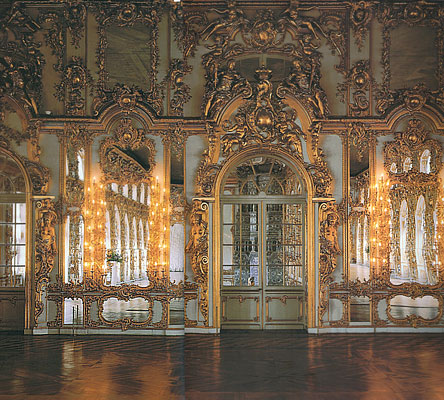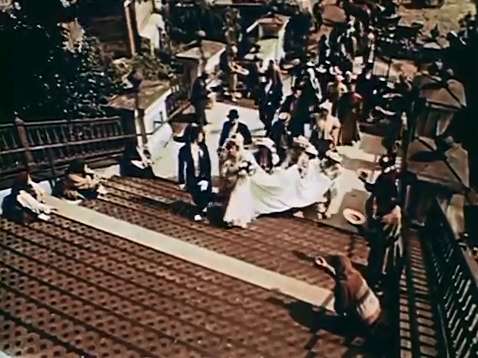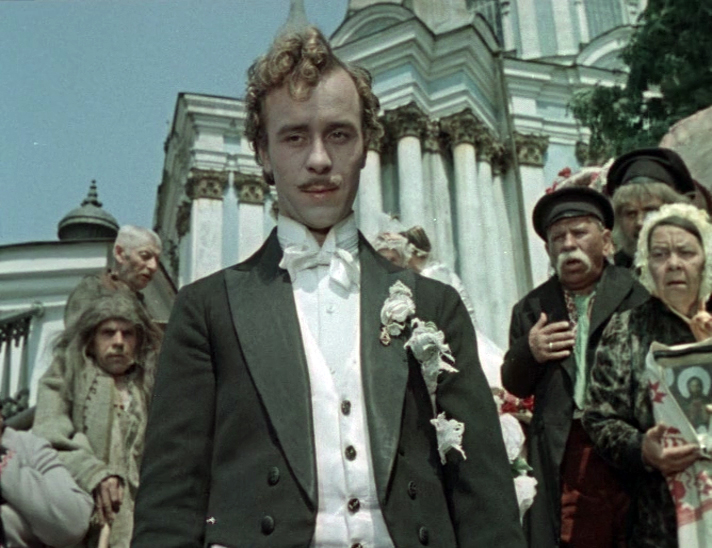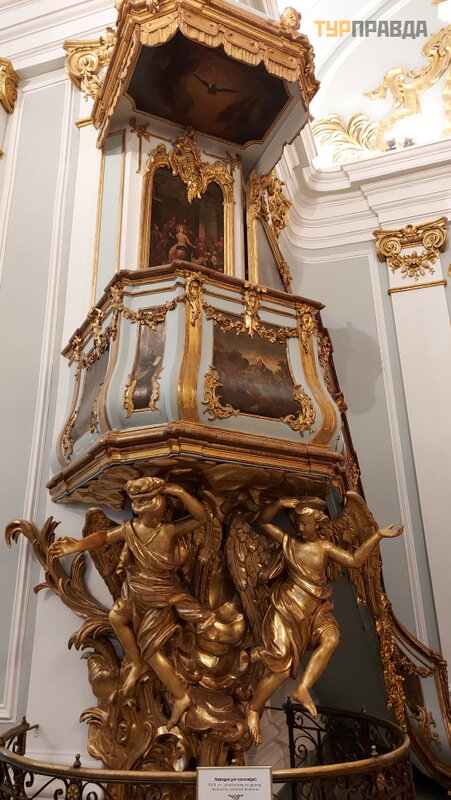"A beautiful monument to a frivolous eyelid" (c)

Symbol of Kyiv Montmartre. Included in the catalog "1000 wonders of the world. Masterpieces of Humanity 5 Continents ", as well as a preliminary list of UNESCO World Heritage sites. The place where the most dramatic events of the comedy "For two hares" took place. It is possible to continue this synonymous series, but I am sure that everyone has already understood - it will be about St. Andrew's Church, which in December 2020 reopened its doors after 11 years of restoration.
In general, the history of the famous temple is an almost continuous chain of restorations and reconstructions. And it was more often closed to parishioners than open. By the way, this is not the first church built on this site and later suffered various disasters. However, the construction of churches here took place with enviable consistency. : )
And all thanks to Nestor the Chronicler and his "Tale of Bygone Years", which mentions that it was here that the Holy Apostle Andrew the First-Called spent the night on the way from Korsun (Chersonesos Tavriya) to Rome and, seeing his open eyes in the morning, prophesied: < em> "Do you see this grief? As the grace of God shines on these mountains, to have a great hailstone and to build many churches, God will build ”. And to confirm his words, he installed a wooden cross on this mountain.
Kyiv, which later spread out on the surrounding hills, served as a confirmation of the apostle's prophecy, and the "calculated" place thanks to Nestor's records has long been considered sacred - in the thirteenth century. there was the Church of the Exaltation of the Cross, which burned down during the invasion of the Tatars. Then, according to sources, the Church of the Epiphany was moved here from the Fraternal Monastery, renaming it St. Andrew's. But it did not last long and was destroyed in 1724.
Then they decided not to try with religious buildings, but simply to build a cross on this place, which was named Andrew.
And here Kyiv was visited by the beloved daughter of the Western reformer Peter I Elizabeth, who at that time was in the status of an autocratic all-Russian.

And Elizaveta Petrovna wanted to build a royal residence in our city (thanks to which the Mariinsky Palace appeared in Kyiv, about which she recently told us deppo ) and complete with a church for the clearest prayers. At the same time, in 1744, the royal hand laid the cornerstone of the church and told the best court architects to develop a construction plan. According to historical sources, "...the new church was to be a magnificent work of art, an eternal monument of the Empress's favor to the ancient capital…".
But the first project by Johann Schedel and Daniel de Bosquet was rejected by Her Majesty, and the creation of a new project was entrusted to the court architect Francesco Bartolomeo Rastrelli. By that time he was already known as the author of several castles built by order of Ernst-Johann von Biron, a favorite of the former Empress Anna Ioannovna, and the Smolny Monastery - commissioned by the current Empress Elizabeth. Later, the tireless Italian built many more architectural gems, distinguished by the richness and luxury of decoration, as well as a certain mixture of styles, which even gave rise to the term "Elizabethan Baroque" (photo here ).


In the case of St. Andrew's Church, Bartolomeo also failed - until 1748 he submitted the project, which received the highest approval, and in 1749.
large-scale construction began under the leadership of I.
Michurin (another court architect), who added to the image of the church. But, unfortunately, neither one nor the other authors of the project did the main thing - they did not divert groundwater from under the mountain on which the temple was built, which was mostly the reason for constant repairs and restorations. Later, the situation only worsened, on the one hand, by flooding and landslides, and on the other - by thunder and lightning, which with enviable regularity fell into the temple, which rises on steep slopes, which did not add security.
The construction of the church lasted from 1749 to 1762, "surviving" his most loyal customer and remaining in this connection as if out of business (read - without proper funding). After the consecration of the temple, which took place in 1767.
, it was transferred to the Kyiv magistrate and then to the Kyiv City Duma just a few months later.
Due to such events, St. Andrew's Church was left without its own parish and, accordingly, a permanent source of income, which allowed to maintain the building, as well as to repair it properly and in the required amounts.
During its more than 200 years of life, the temple has undergone a number of reconstructions and transfers from one department to another. Until 1932, the church remained in operation, then became part of the historical and cultural reserve "All-Ukrainian Museum Town". In 1939, a branch of the Sofia Anti-Religious Museum was located in the church, worship was resumed there during World War II, and the church was closed again in the 1960s. In 1968, St. Andrew's Church was opened as an architectural and historical museum-branch of the Sofia Museum Reserve. And finally, the latest story - in October 2018.
St. Andrew's Church was transferred to the Ecumenical Patriarchate, although it remains a museum within the Sophia of Kyiv National Reserve.
As you can see, the history of the temple is quite turbulent and rich in events. But at the same time it is believed that St. Andrew's Church - one of the best preserved and survived to this day in the authentic form of Rastrelli's works.
Perhaps this was facilitated by the fact that in 1978-79. The next restoration of the church was carried out on the basis of original drawings by a talented architect, copies of which were kindly provided to our restorers by the Vienna Museum of Albertina.
Therefore, I personally was very interested to see St. Andrew's Church after a long restoration.
Moreover, among the achievements she pointed to the restoration of the original color of the walls inside the temple, for which repeated trial painting was carried out.
As well as the restoration of the iconostasis - all the icons in it were restored and arranged in the order that was designed by Bartolomeo and existed during the consecration of the temple.
So, if the theater starts with a hanger, then St. Andrew's Church starts with ходів stairs! : )
Michurin added it to the project of the church, and Pronya Prokopivna said to Golokhvastov: “...I loved you! And you! Shamed the whole of Kyiv! For the whole Division! . ».
 >
>

Going up the stairs, you will find an observation deck, which offers magnificent views of the Dnieper and Kiev's left bank (although not quite this picture was seen in his time by St. Andrew, but I can not share his hobbies)…
… Down…
… Artists' Alley…
… and, of course, Andriyivsky Descent - a favorite place for walks of Kyiv residents and guests of Kyiv.
I must say that when the church was under reconstruction, there was a separate entrance to the observation deck. And now you can buy tickets for a comprehensive visit to the temple (if I'm not mistaken, the ticket price is 70 UAH), and just to climb the observation deck (20 UAH).
The work schedule can be seen on the official website of the St. Andrew's Church .
But it is impressive not only the view from the walls of the church to Kyiv, but also the view of the church from different parts of Kyiv and, in particular, from Podil. It seems that the elegant temple really hovers in the air above the city.
And this effect is especially intensified in the evening.
Although the height of the church is not so great - 50 m with a cross. If we take into account the height of the two-story stylobate, which is a kind of foundation of the church, the total height will be 64 m, which is also not so much.
Adding this stylobate house to the foundation of the church was also Michurin's idea - it allowed to level the difference in height on the mountain and strengthen the foundation of the temple.
The exterior decoration of St. Andrew's Church is striking, especially in the works of Rastrelli's blue-blue exterior walls, contrasting with the whiteness of the columns that adorn the corner buttresses of the church, as well as gilded frames.
Another feature of the exterior decoration is the cast-iron decor, which Rastrelli first used during the construction of St. Andrew's Church. All this beauty was made at Tula metallurgical plants.
But what St. Andrew's Church does not have is a bell tower. And this feature is explained by the same legend about the journey of St. Andrew through our places.
In those days, the sea splashed around this mountain, but when the apostle prophesied his prophecy and put a cross to confirm his words, the sea turned into the Dnieper River, and the rest of the water went down the mountain. However, if you disturb the sea, which is hidden under St. Andrew's Mountain, with some loud sound (the ringing of a bell, for example), it will come out from under the mountain and flood the city along with the entire Left Bank.
Although the absence of the bell tower can be explained and very prosaic: the church was founded exclusively for the Empress, accordingly, she did not have to convene her parishioners for church events with a bell.
But the legend of the sea is, of course, more attractive. Moreover, when laying the foundation of St. Andrew's Church in the bowels of the mountain opened an underground spring (according to other sources - a water well). So the legend, as always, contains some truth. ; )
The church has the shape of a cross with dimensions of about 20x30 m, so the inner part is very small. But it impresses with its splendor and luxury.
Of course, the first thing that catches your eye is the huge iconostasis, consisting of 39 icons, made in red and decorated with gold carvings.
Many elements of decor in order to speed up the work were done in St. Petersburg.
But local Kyiv masters were also involved - they created a frame of the iconostasis, consisting of three tiers, as well as carved frames of icons.
As I mentioned, when the church was not used for its intended purpose, the order of the icons was changed.
Now we see everything in the order that Rastrelli intended, although it should be noted that even then the iconostasis of St. Andrew's Church was considered quite unusual, because in some ways deviated from the strict church canons.
The first (bottom) row of the iconostasis and the Royal Gate, decorated with exquisite carvings, floral ornaments and cherub heads, with images of the four evangelists and scenes of the Annunciation, are considered classic.
The second and third tiers are arranged in a fairly free manner, if such a term can be used to describe the church decoration. : )
All icons were made in 1751-52 by the so-called "picturesque team" of St. Petersburg artists under the leadership of I.
Vyshnyakov, who not only directed but also participated in the writing of some icons. Many paintings are also attributed to A. Antropov's brushes. He delivered all the paintings from St. Petersburg to Kyiv, supervised their placement, carried out other design work for the church - in this regard, the artist stayed in Kyiv for almost 3 years.
His most striking project in St. Andrew's Church is the altarpiece "The Last Supper", dated 1754. The canvas is impressive in size (8.3 sq. M), and experts say that it showed the most of all the works of art used in the design of the church Baroque style of the middle of the XVIII century.
His image is attributed to the image of Andrew the First-Called on the western vault of the church.
And in general, the design of the domed space needs special mention.
It consists of eight triangular sectors, in each of which there is a picturesque panel, in the creation of which probably participated, including A. Antropov.
Behind the Royal Gate in the first tier of the iconostasis attracts attention with its fine carvings and magnificent design of the throne of the throne (or kivory, as I learned when writing this story). It is made in the form of a rotunda with eight twisted columns decorated with flower garlands.
By the way, there is an interesting story connected with it.
The throne has long been covered with a glass cap and metal plates, which were removed during the last restoration, and under them the restorers through a layer of old plaster found an inscription that is well preserved, which lists the holy relics preserved in this throne (now their fate ), as well as the exact date of consecration of the temple. Restorers with a certain amount of humor call this inscription the Birth Certificate of St. Andrew's Church.
In general, it is noteworthy that in St. Andrew's Church, which is an Orthodox church, there are many elements of Catholicism in the interior - the above-mentioned mantle, a round polychrome sculpture, a preaching chair. And the latter, according to Rastrelli's plan and in celebration of his commitment to the luxury of the Baroque style, is made in the form of a miniature theater box ...
яких which leads to a small staircase with a balustrade, richly decorated with stucco, carvings and paintings on religious themes.
And the carved gilded figures of two angels located under the chair seem to carry it on their wings.
Above the stairs to the chair you can see the painting "The Choice of Faith by Prince Vladimir", donated to the 100th anniversary of the church in 1867 by Count Sheremetyev. The canvas is made in the style of classicism by the Courland native artist IL Egginko. The picture shows how representatives of the clergy of different faiths introduce Vladimir to Catholicism, Judaism, Islam and Orthodoxy.
At the same time, as a gift from the Metropolitan of Kyiv Arseniy, the church received a painting by Ukrainian artist PT Boryspil "Sermon of the Apostle Andrew".
Interestingly, the canvas was painted by the author during his stay in Paris in 1847, and almost 10 years later was donated to Kiev. And it is even more interesting that some art critics and connoisseurs of Boryspil's work believe that this painting has a portrait of Taras Shevchenko, with whom the author was very friendly. Indeed, if you look at the image of a man on a black horse from the left edge of the picture, you can see a certain resemblance to the Kobzar.
So when visiting St. Andrew's Church, we can not only admire art objects, but also compare art schools of the XVIII and XIX centuries. , as well as the manner of performance of Russian, Ukrainian and Baltic artists. ; )
Like other gifts for its 100th anniversary, the church received from the royal family an icon, the Gospel and church vestments, and from the patron A.
Muravyov, who actively cared for the church, part of the relics of the Apostle Andrew brought from Mount Athos.
Unfortunately, all of the above is not represented in the church at the moment. There is only such a metropolitan miter of the early XVIII century. :
To be honest, the church itself is small and it won't take long to visit. But given its turbulent history, a lot of legends associated with it, as well as a unique style of exterior and interior decoration, such a tour will bring, I think, a real pleasure for lovers and connoisseurs of history and art.
And at the end of my story I cannot fail to cite the words of Zoya Shamurina, which are often mentioned in stories about St. Andrew's Church. In her collection "Kyiv", published in 1912, researchers of antiquity described the famous Kyiv church as follows:
«… Challenging-bright and red iconostasis, white light walls, abundance of gold and silver, grace capricious lines and ornaments and and laughing angels - how beautiful it all is! ...but how little the temple is in all this, how little it inclines to a prayerful, focused mood!
The temple-palace, elegant and joyful - a magical monument of the frivolous century, when people forgot to pray ...".
And after a recent visit, I'm probably ready to agree with that definition. : )



























































































































